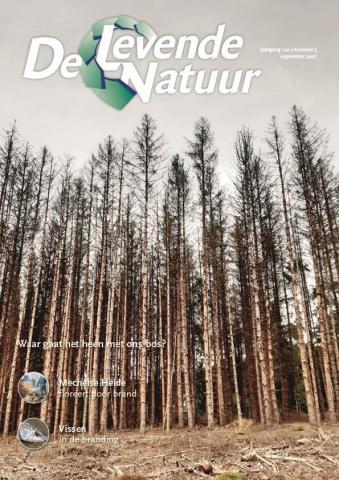De Levende Natuur nummer 5 van 2021 (English summary)
Afbeelding

Half a century of fire management in The Mechelse Heide
Jos Gorissen, Marijke Thoonen, Thomas Gyselinck & Jan Van Uytvanck
Burning heathland has a long history in the Mechelse Heide, a nature reserve (770 ha) at the edge of plateau grounds and Maas river terraces (Flanders, Belgium). Insights on how animals (mainly invertebrates) use vegetation structure and landscape and some large uncontrolled fires changed the management over years. Gradually the surface of burnt patches decreased from up to 30 ha since 1968 to 0.5-2 ha now and is restricted to embossed areas where thermophilic and rare spiders, butterflies and grasshoppers occur. Small-scaled mowing, sod cutting, and grazing were included in the management scheme. To rejuvenate heathland by burning, patches shouldn’t be older than twelve to fifteen years to realize successful germination from seeds. A sheep herd grazes burnt heath patches intensively in short periods during the first years to prevent Molina overgrowing young heath plants. Nowadays the landscape of the Mechelse Heide is a small-scale patchwork of unmanaged, mowed, burnt and sod cutted areas. Recolonization from adjacent heathland habitats is going well. At a larger level, woodland development is controlled and patches with different successional stages are scattered throughout the area allowing animals to spread out as well.
Nature volunteers: who are they, and what motivates them?
Wessel Ganzevoort
Volunteers play a crucial role in conservation of, research on and education about nature. However, relatively little attention is paid to who these volunteers are, what they do and why they do it. Based on a large-scale survey among 3,775 Dutch nature volunteers, this article presents several results on exactly these questions. It focuses specifically on the demographic and activity profile of volunteers, their motivations, and their experiences and perspectives on the future. The findings result in several implications for nature organisations looking to improve their cooperation with volunteers.
Seasonal dynamics of fish species in the surf zone
Bram Couperus, Joey Volwater & Ralf van Hal
The Dutch surf zone is frequently cited as an important nursery for juvenile fish. However, routine fish monitoring occurs outside this zone and consistent knowledge on fish here is limited. In 2019 monitoring of fish in the surf zone was initiated by the RWS-program ‘Natuurlijk Veilig’ and was continued in 2020 by Wageningen Marine Research near IJmuiden. In 2020, sampling by IJmuiden was done every two weeks from March till October. A comparison between the recent data and those of a similar sampling from the 1980s was made on the arrival time of juveniles in the surf zone and the occurrence of species using this area as a nursery. Herring, golden grey mullet, sandeel, and plaice were most frequently caught. In March the first plaice occurred, which is nearly a month earlier than in the 1980s. From April 2020 onwards juvenile golden grey mullet showed up in the catches, and large amounts of juvenile sea bass were observed from August on. Long-term trends in North Sea water temperature suggest that the surf zone became more suitable for species with southern affinities, while for cold-water species it became less suitable. Whether the dynamics have changed structurally must become clear during the beach sampling in the coming years.
Nectar index: the value of road verges for flowering plants and pollinators
Laurens Sparrius, Edwin Dijkhuis, Anthonie Stip & Michiel Wallis de Vries
In 2017, a citizen science project was established for monitoring the quality of road verges for flowering plants and their pollinators. Observations of at least all nectar plants are made in ten sampling points along a 100 m trajectory. This results in a vegetation relevée with 10-point scale for each species. The Nectar index is presented as a new indicator value based on nectar production values from the IPI AgriLand Nectar Database. The Nectar index is a function of nectar plant diversity and abundance and the nectar production of the plot. The monitoring scheme is used by both volunteers and professionals responsible for road verge management and required for a newly developed certification for natural road verges. Participants get an instant management advice for each sampled plot, including mowing frequency, and an analysis based on indicator values for nitrogen and humidity. The results of each road verge can be compared with the entire dataset (benchmark) and monitored in subsequent years.

